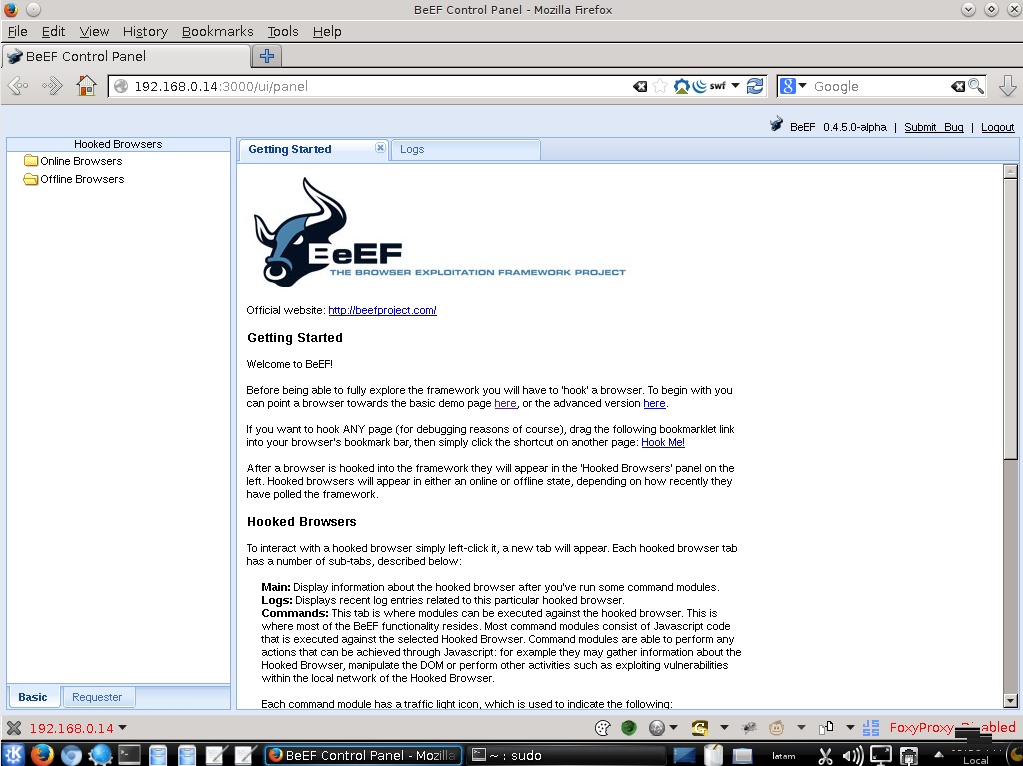BeEF: The Browser Exploitation Framework
Introduction
BeEF (Browser Exploitation Framework) is a powerful tool used primarily by penetration testers and security researchers to assess the security posture of web browsers and the systems they interact with. By leveraging client-side attack vectors, BeEF allows for comprehensive testing and exploitation of browser vulnerabilities.
What is BeEF?
BeEF is designed to hook browsers and exploit the trust relationships they have with web applications. Once a browser is hooked, BeEF can execute various commands and payloads, ranging from simple alerts to complex data exfiltration and browser exploitation techniques.
Key Features and Modules
Functions and Modules
BeEF comes with a rich set of modules and features that facilitate a wide range of attacks, including:
- Social Engineering: Modules to create fake login pages, phishing attacks, and other social engineering techniques.
- Browser Exploits: Exploit vulnerabilities in different browsers to gain further control.
- Network Reconnaissance: Gather information about the network the browser is connected to, including internal IP addresses, routers, and other devices.
- Keylogging and Clipboard Theft: Capture keystrokes and clipboard data from the victim’s browser.
API Access
BeEF also provides an API, allowing developers and security researchers to integrate its functionalities into other tools and automate tasks. This API makes BeEF highly extensible and adaptable to various testing scenarios.
Hooking Browsers with BeEF
Hooking a browser involves injecting a small JavaScript snippet into the target web page. This script establishes a connection back to the BeEF server, allowing it to send commands and receive responses from the hooked browser.
Polling Issues
One common method of maintaining this connection is through polling, where the hooked browser frequently checks in with the BeEF server for new commands. However, this method can lead to performance issues and increased network traffic, especially with a large number of hooked clients. Polling can cause errors and delays, making the interaction less efficient and sometimes unreliable.
Alternatives to Polling
To mitigate these issues, more efficient communication methods, such as WebSockets, can be used. WebSockets provide a persistent connection between the client and server, allowing for real-time communication without the overhead of constant polling. This approach can significantly improve performance and reliability, particularly in environments with many hooked browsers.

Limitations and Challenges
While BeEF is a powerful tool, it is not without its challenges:
- Maintenance: BeEF does not receive frequent updates and maintenance, which can lead to compatibility issues with newer browsers and web technologies.
- Detection: Modern browsers and security tools are becoming better at detecting and blocking BeEF’s hooking script, reducing its effectiveness.
- Performance: As mentioned, using polling for communication can degrade performance, especially with multiple clients.
For more information on BeEF, visit the official BeEF Project page.
Explaining the BeEF-Discord Bot BEEFCORD:
https://github.com/jomoza/beefcord
This Discord bot is designed to manage BeEF clients and interactions via Discord messages. Here’s how it works:
- Initialization: The bot initializes by logging in with the specified Discord token and sets up necessary configurations such as BeEF server domain, port, API token, Discord channel ID, and file paths for client and last sent data.
- Client Ready: Upon successful login, the bot notifies the console and is ready to respond to commands.
- Message Handling: The bot listens for messages from users. When a message starts with !showhost, it interprets the subsequent content as a client ID to query.
- BeEF API Interaction: Using the provided BeEF domain, port, and API token, the bot makes HTTP requests to fetch information about hooked browsers and their sessions.
- Response Handling: Upon receiving data from BeEF API, the bot extracts relevant information such as session details and sends formatted messages to the specified Discord channel.
- Polling Mechanism: The bot periodically checks the number of online clients hooked to BeEF and compares it with the last recorded count. If there’s a change, it updates the client ID file and sends a notification to the Discord channel.
Why Manage BeEF Clients via Discord?
Managing BeEF clients through Discord offers several advantages:
- Accessibility: Users can manage and monitor BeEF clients remotely via Discord from any device.
- Real-time Notifications: The bot provides real-time notifications for new clients and updates, keeping users informed about the status of hooked browsers.
- Automation: Commands can be automated to perform routine tasks, reducing manual effort in monitoring and managing BeEF clients.

Conclusion
Despite its limitations, BeEF remains an essential tool in the realm of client-side hacking. Its comprehensive set of features and modules makes it invaluable for testing and exploiting browser vulnerabilities. While the tool may not receive the most consistent maintenance, its impact and utility in security research are undeniable.
For security professionals and enthusiasts, understanding and leveraging BeEF can provide deep insights into the security weaknesses of web browsers and client-side applications. With proper handling and awareness of its limitations, BeEF continues to be a cornerstone in the toolkit of penetration testers and security researchers.
The integration of BeEF client management with Discord through this bot enhances the usability and accessibility of BeEF for penetration testers and security professionals. By leveraging Discord’s messaging capabilities, users can efficiently monitor and interact with hooked browsers, facilitating comprehensive security assessments and browser exploitation activities.